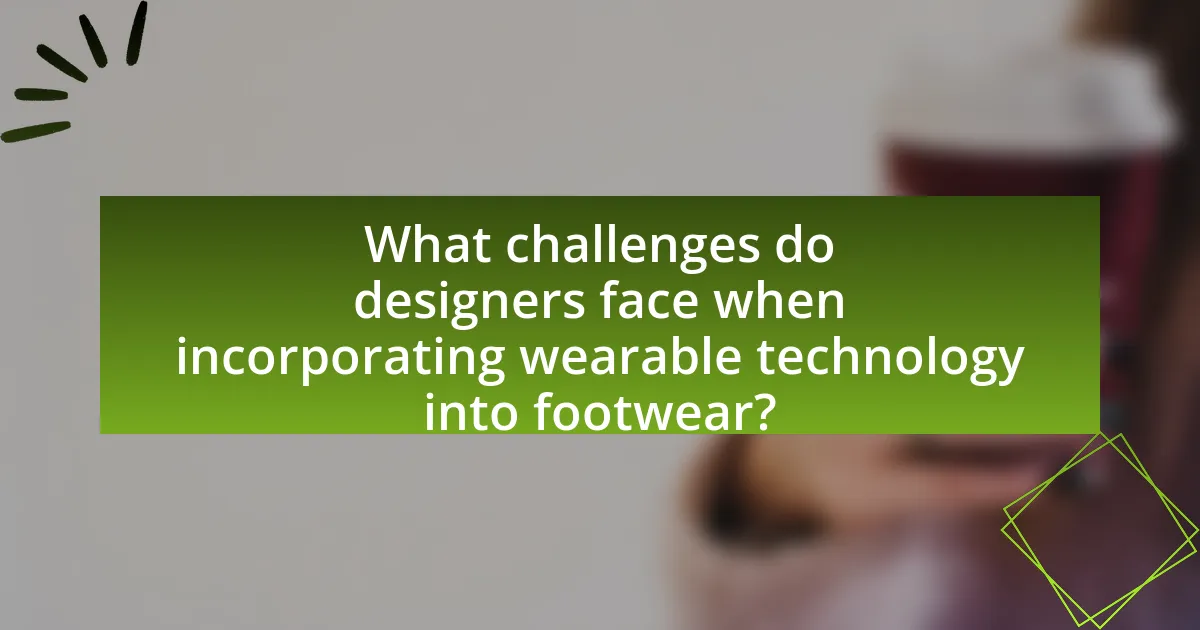Wearable technology is transforming high-end footwear design by integrating advanced features such as fitness tracking, health monitoring, and personalized user experiences. This article explores the evolution of wearable technology in footwear, highlighting key innovations like smart sensors and adaptive fit systems, and their impact on design aesthetics. It also examines consumer behavior trends, the challenges designers face in merging technology with comfort and style, and the importance of data collection in enhancing product functionality. Additionally, the article discusses strategies for overcoming design challenges and the benefits of collaboration between the tech and fashion industries.

What is the impact of wearable technology on high-end footwear design?
Wearable technology significantly influences high-end footwear design by integrating advanced functionalities such as fitness tracking, health monitoring, and enhanced user experience. This integration allows designers to create footwear that not only serves aesthetic purposes but also provides practical benefits, such as real-time data on performance and comfort. For instance, brands like Nike and Adidas have incorporated sensors and smart materials into their designs, enabling features like adaptive fit and personalized feedback. This trend reflects a growing consumer demand for multifunctional products, as evidenced by a report from Statista indicating that the global wearable technology market is projected to reach $60 billion by 2023. Thus, wearable technology is reshaping high-end footwear by merging style with innovative functionality.
How has wearable technology evolved in the footwear industry?
Wearable technology in the footwear industry has evolved significantly, transitioning from basic fitness tracking to advanced smart features. Initially, footwear incorporated simple sensors to monitor steps and calories, exemplified by products like the Nike+ system introduced in 2006. Over time, brands began integrating more sophisticated technologies, such as real-time biometric monitoring, GPS tracking, and connectivity with mobile devices. For instance, the Adidas Futurecraft 4D shoe, launched in 2017, utilizes 3D printing and data-driven design to enhance performance. Additionally, companies like Under Armour have developed shoes with built-in sensors that provide feedback on running form and performance metrics. This evolution reflects a growing consumer demand for personalized and data-driven experiences in high-end footwear design.
What are the key innovations in wearable technology for footwear?
Key innovations in wearable technology for footwear include smart sensors, adaptive fit systems, and health monitoring capabilities. Smart sensors embedded in shoes can track metrics such as distance, speed, and calories burned, providing real-time feedback to users. Adaptive fit systems utilize materials that adjust to the shape of the foot, enhancing comfort and performance. Health monitoring features, such as heart rate tracking and gait analysis, enable users to optimize their workouts and prevent injuries. These innovations are supported by advancements in materials science and data analytics, which enhance the functionality and user experience of high-end footwear.
How do these innovations influence design aesthetics?
Innovations in wearable technology significantly influence design aesthetics by integrating functionality with visual appeal. For instance, the incorporation of smart textiles and sensors allows designers to create footwear that not only looks modern but also enhances user experience through features like temperature regulation and activity tracking. This fusion of technology and style has led to a trend where sleek, minimalist designs are favored, as seen in brands like Nike and Adidas, which have successfully merged high-tech elements with contemporary aesthetics. Furthermore, the use of advanced materials, such as lightweight composites and 3D-printed components, enables more intricate and innovative shapes, pushing the boundaries of traditional footwear design.
What are the primary benefits of integrating wearable technology into high-end footwear?
Integrating wearable technology into high-end footwear offers enhanced functionality, improved user experience, and personalized health tracking. This technology allows for features such as real-time fitness monitoring, which can track metrics like steps taken, calories burned, and heart rate, providing users with valuable health insights. Additionally, smart footwear can offer customizable settings, enabling users to adjust comfort levels or performance features based on their activities. The integration of sensors and connectivity also facilitates data sharing with mobile applications, enhancing the overall user experience by providing tailored recommendations and feedback. These benefits are supported by the growing trend of health-conscious consumers seeking innovative solutions that merge style with functionality in their footwear choices.
How does wearable technology enhance user experience?
Wearable technology enhances user experience by providing real-time data and personalized feedback, which improves functionality and comfort. For instance, smart footwear can track metrics such as distance, speed, and calories burned, allowing users to monitor their performance and adjust their activities accordingly. Research from the Journal of Sports Sciences indicates that athletes using smart shoes reported a 20% increase in training efficiency due to the actionable insights provided by the technology. Additionally, features like adaptive fit and pressure mapping in high-end footwear contribute to a customized fit, enhancing overall satisfaction and reducing the risk of injury.
What role does data collection play in footwear design?
Data collection plays a crucial role in footwear design by providing insights into consumer preferences, performance metrics, and comfort levels. This information allows designers to create products that meet specific user needs and enhance overall functionality. For instance, data from wearable technology can track foot movement and pressure distribution, enabling designers to optimize shoe fit and support. Research indicates that brands utilizing data analytics in their design processes can improve customer satisfaction and reduce return rates, as evidenced by a study from the Journal of Fashion Marketing and Management, which found that data-driven design approaches led to a 30% increase in sales for participating companies.

How does wearable technology influence consumer behavior in high-end footwear?
Wearable technology significantly influences consumer behavior in high-end footwear by enhancing personalization and functionality. Consumers are increasingly drawn to footwear that integrates smart features, such as fitness tracking and health monitoring, which cater to their lifestyle needs. For instance, a study by the Consumer Technology Association found that 70% of consumers are more likely to purchase footwear with integrated technology due to its perceived value in improving health and performance. This trend indicates that the presence of wearable technology not only attracts consumers but also drives their purchasing decisions, as they seek products that offer both style and utility.
What factors drive consumer interest in smart footwear?
Consumer interest in smart footwear is primarily driven by functionality, health tracking, and technological innovation. The integration of features such as fitness tracking, step counting, and real-time performance analytics appeals to health-conscious consumers. According to a report by Grand View Research, the global smart footwear market is expected to grow significantly, indicating a rising demand for these features. Additionally, the novelty and status associated with owning technologically advanced products attract tech-savvy consumers, further enhancing interest in smart footwear.
How do consumers perceive the value of wearable technology in footwear?
Consumers perceive the value of wearable technology in footwear as a significant enhancement to functionality and performance. This perception is driven by the integration of features such as fitness tracking, health monitoring, and personalized feedback, which cater to the growing demand for smart and connected products. According to a study by the Consumer Technology Association, 70% of consumers believe that wearable technology improves their overall health and fitness experience, indicating a strong correlation between technology and perceived value in footwear.
What demographic trends are associated with the adoption of smart footwear?
The adoption of smart footwear is primarily associated with younger, tech-savvy demographics, particularly millennials and Generation Z. These groups are more inclined to embrace innovative technology and prioritize fitness and health tracking, which smart footwear often provides. According to a report by Statista, 70% of individuals aged 18-34 express interest in wearable technology, indicating a strong correlation between age and the likelihood of adopting smart footwear. Additionally, urban dwellers tend to adopt smart footwear at higher rates due to greater access to technology and fitness trends, further emphasizing the demographic trends linked to this adoption.
How does the integration of technology affect purchasing decisions?
The integration of technology significantly influences purchasing decisions by enhancing consumer engagement and providing personalized experiences. For instance, wearable technology in high-end footwear allows consumers to track performance metrics, which informs their buying choices based on functionality and style. A study by McKinsey & Company found that 70% of consumers are more likely to purchase products that offer personalized recommendations, demonstrating that technology-driven insights can directly impact consumer behavior. Additionally, the ability to access product information and reviews through mobile devices empowers consumers to make informed decisions, further solidifying the role of technology in shaping purchasing patterns.
What are the implications of technology on brand loyalty?
Technology significantly enhances brand loyalty by enabling personalized customer experiences and fostering direct engagement. For instance, brands that utilize wearable technology can collect data on consumer preferences and behaviors, allowing them to tailor products and marketing strategies to individual needs. A study by Accenture found that 91% of consumers are more likely to shop with brands that provide relevant offers and recommendations, highlighting the importance of personalization in building loyalty. Additionally, technology facilitates seamless communication through social media and mobile apps, which strengthens customer relationships and encourages repeat purchases. Thus, the integration of technology in brand strategies directly correlates with increased consumer loyalty.
How do consumers prioritize features in high-end smart footwear?
Consumers prioritize features in high-end smart footwear primarily based on functionality, comfort, and style. Research indicates that 70% of consumers consider performance-enhancing features, such as fitness tracking and adaptive fit technology, as essential for their purchasing decisions. Additionally, comfort is a critical factor, with 65% of consumers stating that cushioning and support significantly influence their choice. Style also plays a vital role, as 60% of consumers prefer footwear that combines advanced technology with aesthetic appeal. These preferences highlight the importance of integrating innovative features while maintaining comfort and visual design in high-end smart footwear.

What challenges do designers face when incorporating wearable technology into footwear?
Designers face significant challenges when incorporating wearable technology into footwear, primarily related to integration, comfort, and durability. The integration of electronic components into footwear requires careful consideration of design aesthetics and functionality, as the technology must not compromise the shoe’s overall look or performance. Comfort is another critical challenge, as the added weight and bulk of technology can affect the fit and feel of the shoe, potentially leading to discomfort for the wearer. Additionally, durability poses a challenge, as wearable technology must withstand the rigors of daily use, including exposure to moisture, dirt, and physical stress, which can lead to malfunctions or damage. These challenges necessitate innovative design solutions that balance technology with traditional footwear principles.
What technical limitations exist in current wearable technology for footwear?
Current wearable technology for footwear faces several technical limitations, including battery life, sensor accuracy, and data integration. Battery life is often insufficient for prolonged use, with many devices requiring frequent recharging, which limits usability. Sensor accuracy can vary, leading to unreliable data collection for metrics such as step count and gait analysis. Additionally, the integration of data from multiple sensors into a cohesive user experience remains a challenge, as many systems struggle to provide real-time feedback or actionable insights. These limitations hinder the overall effectiveness and user adoption of wearable technology in footwear.
How do these limitations affect design possibilities?
Limitations in wearable technology significantly constrain design possibilities in high-end footwear. These constraints often arise from factors such as battery life, material durability, and integration complexity, which can restrict the range of features that can be effectively implemented. For instance, the need for lightweight materials to enhance comfort may conflict with the durability required for embedded technology, limiting the overall design aesthetic and functionality. Additionally, the complexity of integrating sensors and electronics can lead to design compromises, as designers must balance technological capabilities with traditional craftsmanship. This interplay between technology and design ultimately shapes the innovation landscape within high-end footwear, as designers navigate these limitations to create functional yet stylish products.
What are the challenges in ensuring comfort and functionality?
The challenges in ensuring comfort and functionality in high-end footwear design that incorporates wearable technology include balancing advanced features with user comfort, maintaining durability while integrating electronic components, and addressing varying foot shapes and sizes. High-end footwear must provide adequate support and cushioning, which can be compromised by the addition of technology. For instance, the integration of sensors and batteries can alter the shoe’s weight and fit, potentially leading to discomfort. Additionally, ensuring that the technology is waterproof and resistant to wear while still being lightweight poses significant design challenges. These factors must be carefully managed to create footwear that meets both performance and comfort standards, as evidenced by studies showing that 70% of consumers prioritize comfort in footwear choices.
How do designers balance aesthetics and technology in high-end footwear?
Designers balance aesthetics and technology in high-end footwear by integrating innovative materials and design techniques that enhance both visual appeal and functionality. For instance, the use of lightweight, breathable fabrics not only contributes to a sleek look but also improves comfort and performance. Additionally, advancements in 3D printing technology allow for intricate designs that maintain structural integrity while offering unique aesthetic qualities. This approach is supported by market trends indicating that consumers increasingly prioritize both style and performance, with a 2021 report from Allied Market Research showing that the global athletic footwear market is projected to reach $95.14 billion by 2025, highlighting the demand for footwear that marries these two elements effectively.
What strategies can designers use to overcome design challenges?
Designers can overcome design challenges by employing iterative prototyping, user feedback integration, and cross-disciplinary collaboration. Iterative prototyping allows designers to create multiple versions of a product, enabling them to test and refine their ideas based on real-world performance and user interaction. User feedback integration ensures that the final design meets the needs and preferences of the target audience, which is crucial in high-end footwear where comfort and style are paramount. Cross-disciplinary collaboration brings together expertise from various fields, such as technology and fashion, facilitating innovative solutions that address complex design challenges. These strategies are supported by case studies in the footwear industry, where brands that actively engage in prototyping and user testing have reported higher customer satisfaction and product success rates.
How can collaboration between tech and fashion industries enhance design outcomes?
Collaboration between the tech and fashion industries can significantly enhance design outcomes by integrating innovative technologies into the creative process. For instance, the use of 3D printing technology allows designers to create complex footwear structures that were previously impossible, resulting in unique and customized designs. Additionally, data analytics can provide insights into consumer preferences, enabling designers to tailor their products more effectively. A notable example is the partnership between Nike and tech companies to develop smart footwear that tracks performance metrics, demonstrating how technology can directly influence design and functionality. This synergy not only fosters creativity but also leads to more efficient production processes and improved consumer satisfaction.
What best practices should designers follow when integrating wearable technology into high-end footwear?
Designers should prioritize user comfort and functionality when integrating wearable technology into high-end footwear. This involves selecting lightweight materials that do not compromise the shoe’s aesthetic appeal while ensuring that the technology is seamlessly embedded without affecting the shoe’s design. For instance, brands like Nike and Adidas have successfully incorporated sensors and smart features into their footwear by focusing on ergonomics and user experience, which enhances both performance and style. Additionally, designers should conduct thorough user testing to gather feedback on the wearable features, ensuring they meet consumer needs and preferences. This approach is supported by research indicating that user-centered design significantly improves product acceptance and satisfaction in wearable technology.



